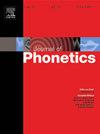The effect of rhythm on inter-gestural coupling of onset and vowel gestures and predictive timing in stuttering
IF 2.4
1区 文学
0 LANGUAGE & LINGUISTICS
引用次数: 0
Abstract
In this study we investigate articulatory timing in fluent speech production in persons who stutter (PWS) and persons who do not stutter (PWNS) by focusing on consonant–vowel (CV)-timing, which refers to the coupling of onset consonant and vowel gestures, as well as on predictive timing, which describes the synchronization of the speech onset to a rhythmic event. These two timing mechanisms are particularly interesting to investigate in relation to stuttering, given that CV-timing is especially challenging for PWS and that they exhibit differences in predictive timing related to speech-motor and manual-motor tasks, suggesting that disturbances in inter-gestural coordination and auditory-motor integration may contribute to stuttering. To shed further light on this, we examine CV-timing and predictive timing under different rhythmic conditions.
Twenty German-speaking adults (10 PWS and 10 PWNS) were recorded using electromagnetic articulography (EMA). Participants produced target words that started with a bilabial onset, followed by a vowel (/a/, /o/, or /u/) and were embedded in a carrier phrase in four different conditions: Unpaced (speaking), Tapping (speaking while concurrently tapping), Metronome (synchronizing speech to a metronome), and Metronome+Tapping (speaking to a metronome while concurrently tapping).
We found evidence for both CV-timing and predictive timing differences between PWS and PWNS. Our results suggest that in general, PWS time CV gestures closer together. However, CV-timing differences were linked to condition in an unexpected way. As to predictive timing, PWS initiated their speech later to a metronome beat than PWNS but they did not differ when timing speech to their own finger tapping, indicating that motor-pacing may stabilize the speech motor system of PWS. In the Metronome+Tapping condition, the groups appeared to rely on different rhythmic cues. While PWNS timed their speech more towards the metronome beat, PWS synchronized their speech onset closer to the finger tap. We discuss that this difference could result from differences in CV-timing. Furthermore, the potential for future research on the interplay of non-verbal and verbal motor systems and the possible benefit for the stuttering population is discussed.
节奏对口吃起音和元音手势的手势间耦合及预测时间的影响
在本研究中,我们研究了口吃者(PWS)和非口吃者(PWNS)在流利言语产生中的发音时间,重点关注辅音-元音(CV)时间,这是指辅音和元音的开始手势的耦合,以及预测时间,这描述了语音开始与节奏事件的同步。这两种计时机制对口吃的研究尤其有趣,因为对PWS来说,cv计时尤其具有挑战性,而且他们在言语-运动和手动-运动任务相关的预测计时方面表现出差异,这表明手势间协调和听觉-运动整合的障碍可能导致口吃。为了进一步阐明这一点,我们研究了不同节奏条件下的cv计时和预测计时。使用电磁关节造影(EMA)对20名讲德语的成年人(10名PWS和10名PWNS)进行了记录。参与者提出的目标词以双音节开头,后面跟着一个元音(/a/, /o/或/u/),并在四种不同的条件下嵌入载体短语:无节奏(说话),敲击(说话时同时敲击),节拍器(将语音与节拍器同步),节拍器+敲击(同时敲击节拍器说话)。我们发现了PWS和PWNS之间cv时间和预测时间差异的证据。我们的研究结果表明,在一般情况下,PWS时间CV手势更接近。然而,cv时间的差异以一种意想不到的方式与病情联系在一起。在预测计时方面,PWS比PWNS晚于节拍器节拍启动言语,但在将言语计时为自己的手指轻敲时,两者没有差异,说明运动起搏可能稳定了PWS的言语运动系统。在节拍器+敲击条件下,各组似乎依赖于不同的节奏线索。PWNS的说话时间更接近节拍器的节拍,而PWS的说话时间更接近手指的敲击。我们讨论了这种差异可能是由于cv时间的差异造成的。此外,本文还讨论了未来研究非语言和语言运动系统相互作用的潜力以及对口吃人群可能带来的好处。
本文章由计算机程序翻译,如有差异,请以英文原文为准。
求助全文
约1分钟内获得全文
求助全文
来源期刊

Journal of Phonetics
Multiple-
CiteScore
3.50
自引率
26.30%
发文量
49
期刊介绍:
The Journal of Phonetics publishes papers of an experimental or theoretical nature that deal with phonetic aspects of language and linguistic communication processes. Papers dealing with technological and/or pathological topics, or papers of an interdisciplinary nature are also suitable, provided that linguistic-phonetic principles underlie the work reported. Regular articles, review articles, and letters to the editor are published. Themed issues are also published, devoted entirely to a specific subject of interest within the field of phonetics.
 求助内容:
求助内容: 应助结果提醒方式:
应助结果提醒方式:


